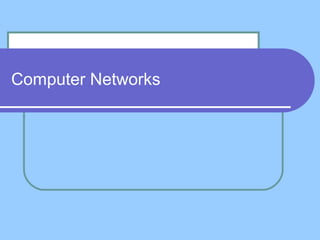
Introduction to computer networking
- 2. Definitions Network Definition A network can be defined as two or more computers connected together in such a way that they can share resources. The purpose of a network is to share resources.
- 3. Definitions (cont..) A resource may be: A file A folder A printer A disk drive Or just about anything else that exists on a computer.
- 4. Definitions (cont..) A network is simply a collection of computers or other hardware devices that are connected together, either physically or logically, using special hardware and software, to allow them to exchange information and cooperate. Networking is the term that describes the processes involved in designing, implementing, upgrading, managing and otherwise working with networks and network technologies.
- 5. Advantages of networking Connectivity and Communication Data Sharing Hardware Sharing Internet Access Internet Access Sharing Data Security and Management Performance Enhancement and Balancing Entertainment
- 6. The Disadvantages (Costs) of Networking Network Hardware, Software and Setup Costs Hardware and Software Management and Administration Costs Undesirable Sharing Illegal or Undesirable Behavior Data Security Concerns
- 7. Classification of Networks Based on function Data Networks Voice Networks Multimedia Networks Based on area coverage LAN MAN WAN
- 8. Classification of Networks Based on ownership Public Network Private Network VPN (virtual private network) Leased Network Based on media Wired Network Wireless Network
- 9. Classification of Networks Based on forwading Switched Network Shared Network Hybrid Network
- 10. Fundamental Network Classifications Local Area Networks (LANs): A local area network (LAN) is a computer network covering a small geographic area, like a home, office, or group of buildings. A local area network may serve as few as two or three users or as many as thousands of users.
- 12. Fundamental Network Classifications (cont) The Local Network (LAN) Client ClientClient Client Client Client
- 13. Fundamental Network Classifications Wide Area Networks (WANs): Wide Area Network (WAN) is a computer network that covers a broad area (i.e., any network whose communications links cross metropolitan, regional, or national boundaries). Or, less formally, a network that uses routers and public communications links The largest and most well-known example of a WAN is the Internet. WANs are used to connect LANs and other types of networks together, so that users and computers in one location can communicate with users and computers in other locations
- 15. Fundamental Network Classifications Metropolitan Area Network (MAN): • A metropolitan area network (MAN) is a network that interconnects users with computer resources in a geographic area or region larger than that covered by even a large local area network (LAN) but smaller than the area covered by a wide area network (WAN). • The term is applied to the interconnection of networks in a city into a single larger network (which may then also offer efficient connection to a wide area network). • It is also used to mean the interconnection of several local area networks by bridging them with backbone lines.
- 16. Fundamental Network Classifications (cont) Metropolitan Area Network (MAN)
- 17. Components of Computer Network Sender (Source Host) Communication interface devices Communication channel Receiver (Destination Host) Communication software
- 18. Sender (Source Host) A host is any computer on a network that is repository for services available to other computers on a network. Sender is the system or node which sends the data through the computer network. It is also called source host.
- 20. Communication channel Guided media: Twisted pair, coaxial cable and fiber optics. Unguided media: Wireless.
- 21. Communication Software It is used to manage the flow of data across a network. The functions of communication software are as follows: •Access Control •Network Management •Data and file transmission •Error detection and control •Data security
- 22. Receiver (Destination Host) Receiver is the system or node which receives the data through the computer network. It is also called destination host.
- 23. Client and Server computer role in networking Server computer is a core component of the network, providing a link to the resources necessary to perform any task. A server computer provides a link to the resources necessary to perform any task. The link it provides could be to a resource existing on the server itself or a resource on a client computer. Client computers normally request and receive information over the network client. Client computers also depends primarily on the central server for processing activities
- 24. Peer-to peer network A peer-to-peer network is a network where the computers act as both workstations and servers. great for small, simple, and inexpensive networks. In a strict peer-to-peer networking setup, every computer is an equal, a peer in the network. Each machine can have resources that are shared with any other machine. There is no assigned role for any particular device, and each of the devices usually runs similar software. Any device can and will send requests to any other.
- 25. Peer-to peer network (cont..)
- 26. Client/Server Networking In this design, a small number of computers are designated as centralized servers and given the task of providing services to a larger number of user machines called clients
- 28. Network topology A topology is a way of “laying out” the network. Topologies can be either physical or logical. Physical topologies describe how the cables are run. Logical topologies describe how the network messages travel
- 29. Network topology (cont.) Bus (can be both logical and physical) Star (physical only) Ring (can be both logical and physical) Mesh (can be both logical and physical)